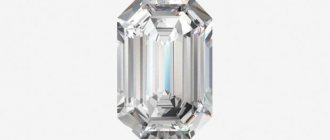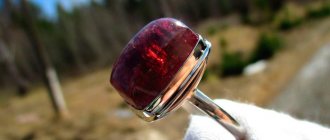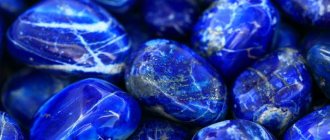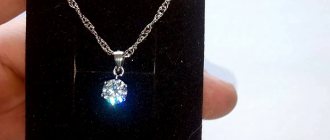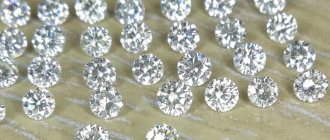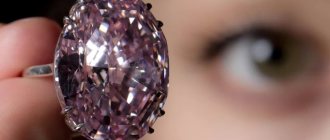Greetings friends! Do you know what is the difference between a diamond and a diamond? Or maybe they are one and the same? I will tell you all the most interesting things about how a diamond is transformed into a brilliant, what path it takes and by what criteria diamond cutting is assessed in the modern world, in Russia and in the West.
A diamond is a diamond, only after it has been cut. There are a lot of finishing variations. But I especially want to highlight the so-called rocks. This finishing is also used, but not so often.
A brilliant cut is not a nugget shape. The name comes from the word “face”, and therefore means the number of faces and location. In simple words, this is nothing more than polishing. The ability of the nugget to reflect light and please the eye will depend on its quality and character. Do you know who developed the classic diamond cut, which is still used today, how it is classified and does it affect the cost of the breed? The most interesting things are below!
What makes this stone so unusual and valuable?
It's not just its weight, color and purity. In order for a cloudy diamond to sparkle with its ideal facets, real skill and talent of cutter jewelers is required. The shape of the future diamond is chosen with special care to be able to demonstrate the full potential of the stone.
Today, about 15 cutting options are known, and each of them has its own characteristics. However, it is worth remembering that human imagination is limitless and in the future, more than one, no less spectacular and interesting form will probably be invented, which will give enthusiastic diamond admirers thousands of sparkling facets.
Standard Diamond Processing
In the 21st century, all stages of the cutting process have been precisely developed. Science and technology make it possible to model future diamonds in 3D format by entering the necessary parameters into the program. This eliminates the need for the craftsman to determine the number, length and width of edges by eye.
There are 4 stages in the birth of a diamond. How diamonds are cut:
- The stone is scanned with X-rays, looking for cracks in it. X-rays are used to determine the exact position of the diamond in the mined rock. Based on the information received, a cut is made.
- After being separated from the rock and divided into pieces, each specimen is subjected to grinding on a specially designed lathe. This gives the stone the intended shape and the required number of edges.
- Next, the diamond is generously treated with diamond powder mixed with olive oil and polished on special iron wheels. This gives smoothness.
- Polishing completes the process. With its help, the product acquires its final shine.
In addition to watching a program about cutting in Russia:
Round classic cut
The familiar round shape of a diamond is recognized as the most beautiful, capable of presenting the stone most advantageously and effectively. A regular round cut diamond has 57 facets.
Advertising - Continued below
For very small stones, a simplified cut of 17 facets is used, and for the largest stones there are options with 74, 86 (royal cut) or 102 facets (majestic).
Old processing type
The first diamond cutters were in India, they carved an octagon from a gem, which was considered a sacred ritual. By the 14th century, craftsmen appeared in Europe to carve diamonds with edges that add shine. In 1465, by order of the Duke, the first product resembling a rose-cut diamond was made.
In 1919, Marcel Tolkowsky carried out calculations and came up with two diamond cutting schemes - round and brilliant. It marked the beginning of the era of transformation of minerals into jewelry.
Since 1919, cutting has been practiced according to the development of M. Tolkovsky:
- on top there was a flat platform - the crown;
- the base tapered, almost turning into a sharp tip;
- there was a belt around the perimeter;
- the product received 57 edges.
The method was very popular - before this, the stones practically did not shine. It was used until 1965, when Arpad Neji developed a diamond processing scheme in which he increased the number of facets to 65. Then, more and more new types of cutting began to appear, driven by buyer demand for a variety of diamonds, rather than the same type.
Diamond processing has been carried out in Russia since 1963. The first one was launched in Moscow. Cutting was carried out according to the then fashionable types of round cut, “princess”, “rose”, etc.
Princess cut
Another very popular diamond cut. It became an evolutionary form of the Baryon and Quadrillion cuts.
Thanks to the large number of facets (up to 68), the “Princess” is almost as good as the round shape in terms of the “play” of light in the stone, and given its more affordable price, it is becoming increasingly popular and interesting to a wide range of buyers.
Advertising - Continued below
The advantage of the square shape is that, compared to the round shape, much less raw material is lost during the cutting process.
Main types of diamond cuts
The list of diamond finishes has been updated with new names today. These are the forms:
- Round;
- Princess;
- Oval;
- Pear;
- Marquis;
- Emerald;
- Radiant;
- Asher;
- Trilliant;
- Baguette;
- Heart.
Classic - round shape. During processing, the mineral loses a lot of weight. According to statistics, 75% of precious stones sold are round cut. The basis of the form is the crown, girdle pavilion. The number of faces is 57-58. The maximum effect can be achieved by maintaining the proportions.
The Marquis is an example of a fantasy form. Visually, such a stone resembles a boat based on a wedge cut. Another wedge shape is a pear or a drop. One of the favorites among connoisseurs of diamonds in pendants and pendants.
The oval shape is based on a wedge cut. Suitable for large nuggets and almost all types of products.
Princess is a square or rectangle shape with clear corners. A stone in this treatment gracefully plays with light; it is often used as a mono-insert in pendants, rings and brooches.
An example of a stepped rectangular finish is emerald. The pebbles are shaped into an octagon with softened corners. A variety of emerald form is Ascher. The cut combines newfangled technologies and medieval charm.
The radiant gives rocks the shape of a rectangle or square with an octagonal outline. A cross between a round diamond and an elegant emerald.
A striking example of a fancy cut is the heart. Heart-shaped stones look touching and romantic. In essence, this is a nugget in the shape of the same Drop or Pear, split in two in the head area.
Trilliant is a triangle-shaped stone with a different number of sides. It changes depending on the master’s idea and the characteristics of the nugget. Ideal for rocks as side inserts on rings with a large nugget in the center.
Baguette is another example of a step cut. The shape is close to a square, trapezoid or rectangle.
How is the cut category designated?
You can figure out the type of diamond finish and the characteristics of the stone in a product yourself if you know exactly what the list of numbers on the tag means.
Let's practice together. Let's take as an example a product - a ring with an insert of diamonds. The label says: 8 Br. Kr 57-1.03 4/6. What does it all mean? The first number - 8 - is the number of diamonds in the product. Kr means round cut. 57 is the facets, 1.03 is the total mass of the stones, 4 and 6 are the quality of the color and structure of the nugget. The higher these numbers, the further the color is from the most expensive colorless, and the surface from flawless. The number 6 indicates the presence of defects: chips, cracks, etc. Visually, they are almost invisible, especially to a non-professional.
The quality of the cut is determined by the designation, also written in the documentation for the product. The generally accepted global assessment system involves division into:
- Excellent;
- Very good or good (Very Good, Good);
- Average (Fair);
- Unsatisfactory (Poor).
In Russia, finishing is divided into categories designated by letters:
- A (best);
- B (good);
- B (satisfactory);
- G (bad).
If we compare both classification options, the Russian one is more strict. Diamonds rated “Ideal” in the West can be rated “Good” or even “Satisfactory” with us. The quality of polishing, proportionality and number of edges are assessed.
In general, the main criterion for evaluating processing is human perception. It is important that you like the nugget and impress with its ability to play with light. It happens that a diamond meets the highest standards according to the evaluation scheme, but does not evoke positive emotions among buyers. Therefore, you need to focus on certificates with expert assessments, but it is better to make your choice based on your own impressions.
Marquise cut (Marquise)
It is believed that the cut received its name in honor of the favorite of Louis XV, the Marquise de Pompadour, or more precisely, her smile.
A diamond of such an unusual elongated shape is able to visually lengthen the fingers of its owner, giving them a more graceful appearance. The cut has 55 facets. More information about “Marquise” can be found in this article.
Advertising - Continued below
Brilliant cut and mixed styles.
Brilliant cuts have facets designed to maximize the brilliance of the stone. The classic round cut is brilliant cut.
Step cuts, on the other hand, have facets that are parallel to each other and located at the edge of the stone; they do not increase the brilliance or sparkle of the diamond. An example of a step cut is emerald.
Mixed cuts have both brilliant and stepped details. For example, “Radiant” is a type of mixed cut.
"Fancy" cuts.
A fancy cut is any diamond cut that differs from the classic round cut. For example, pear, heart and oval are unusual diamond cuts.
Cutting grade.
There are different ways to certify a diamond cut, but in general, a cut is graded based on how close its proportions are to generally accepted ones.
Round cut grading is the most common standard for certification, and the guidelines for its proportions are quite detailed. Standards for certification of other cuts are not as detailed and are usually less stringent.
Oval cut
It is related to the round cut, but often looks more advantageous due to the larger top plate at the same weight.
An additional advantage is that a stone of this shape looks good even on a hand with not very long fingers, as it visually stretches them. Has 57 edges.
Advertising - Continued below
What does an uncut diamond look like?
Diamond cutting changes the natural gem dramatically. If you compare the crystal before and after the process, it is difficult to believe that it is the same stone. Giving it shape and edges makes it shine and shimmer with all the colors of the rainbow, giving it transparency.
Before cutting, a diamond looks completely different from a processed mineral:
- uneven shape;
- no shine;
- there may be inclusions, impurities;
- dark or black.
Uncut diamonds are not in mass demand, although there are individual collectors who purchase just such stones, but these are isolated cases.
Emerald or Asscher cut
The “emerald” cut is most often used on fairly large stones and, due to the large size of the upper platform, is a very “open” shape.
For this reason, any visual defect in the stone will be very noticeable, which means that this cut should only be used on high-quality diamonds. In this article you can learn more about the emerald cut and admire the most beautiful diamond rings of this shape.
Advertising - Continued below
The Asscher cut was invented by the Asscher brothers of Antwerp in 1902. Its main difference from “Emerald” is its square shape.
However, “Asher” also allows the use of this form only on stones of ideal purity.
Diamond structure
The types and shapes of diamond cuts determine the structure of the crystal. All processed diamonds have a clear structure.
Regardless of the shape that the diamond cut gives them, a properly designed diamond must consist of the following parts:
- “Crown” is the top of the stone. It is also divided into main elements: a platform (a flat surface to which the edges adjoin), the main edges of the top, single wedges of the top (star facets), a number of paired wedges of the top.
- “Girdle” is a strip separating the crown and the lower part. A diamond cutter can be considered a high professional if he managed to make the girdle minimal in width. In addition to the separating function, this element performs a protective mission (from chipping) and an aesthetic one - the improvised line thins out the light with which the edges play beautifully.
- “Pavilion” is the lower pointed spike. Its elements: the main facets of the bottom, a series of wedge-shaped edges of the bottom. They converge at the lowest point - the culet. There is a standard measure for pavilion that is 43.4% of the total diameter of the diamond. If the cut diamond has a pavilion that is too flat, there will be no back reflection of light from the crown. The same thing is observed when the lower part of the stone is too deep. As a result, the gem itself will not radiate its famous mystical shine.
It is noteworthy that for each element of the crystal structure one or another characteristic can be determined.
Thus, the contour of the platform and how many facets a diamond has “give out” the type of grinding, and the shape of the diamond cut can be recognized by the contour of the girdle.
Navigation
Personal tools
- You did not introduce yourself to the system
- Discussion
- Contribution
- Create an account
- To come in
Namespaces
- Article
- Discussion
Options
Views
- Read
- Current version
- Edit
- Edit code
- Story
More
Search
Navigation
- Home page
- Categories
- Index A - Z
- Featured Articles
- Random page
- Current events
Participation
- Report a bug
- Community
- Forum
- Fresh edits
- New pages
- Reference
- Donate
Tools
- Links here
- Related edits
- Service pages
- Permanent link
- Page details
- Quote page
- Wikidata element
Print/Export
- Create a book
- Download as PDF
- print version
In other languages
- Bulgarian
- Catala
- Deutsch
- English
- Español
- فارسی
- ગુજરાતી
- Bahasa Indonesia
- Kazakh
- 한국어
- Latviešu
- Netherlands
- Norsk nynorsk
- Norsk bokmål
- Polski
- Português
- Svenska
- ไทย
- Türkçe
- Ukrainian
- Oʻzbekcha/uzbekcha
- Tiếng Việt
- 中文
- 粵語
Edit links
- This page was last edited on December 9, 2020 at 04:59.
- The text is available under a Creative Commons Attribution-ShareAlike license; In some cases, additional conditions may apply. See Terms of Use for details. Wikipedia® is a registered trademark of the Wikimedia Foundation, Inc.
- Privacy Policy
- Wikipedia Description
- Denial of responsibility
- Contact us
- mobile version
- Developers
- Statistics
- Cookie Statement
Cubic
zirconia
- an artificially produced mineral, crystals of zirconium dioxide ZrO2, having a cubic system. Widely used in jewelry to imitate precious stones.
Navigation
Personal tools
- You did not introduce yourself to the system
- Discussion
- Contribution
- Create an account
- To come in
Namespaces
- Article
- Discussion
Options
Views
- Read
- Current version
- Edit
- Edit code
- Story
More
Search
Navigation
- Home page
- Categories
- Index A - Z
- Featured Articles
- Random page
- Current events
Participation
- Report a bug
- Community
- Forum
- Fresh edits
- New pages
- Reference
- Donate
Tools
- Links here
- Related edits
- Service pages
- Permanent link
- Page details
- Quote page
- Wikidata element
Print/Export
- Create a book
- Download as PDF
- print version
In other languages
- Bulgarian
- Catala
- Deutsch
- English
- Español
- فارسی
- ગુજરાતી
- Bahasa Indonesia
- Kazakh
- 한국어
- Latviešu
- Netherlands
- Norsk nynorsk
- Norsk bokmål
- Polski
- Português
- Svenska
- ไทย
- Türkçe
- Ukrainian
- Oʻzbekcha/uzbekcha
- Tiếng Việt
- 中文
- 粵語
Edit links
- This page was last edited on December 9, 2020 at 04:59.
- The text is available under a Creative Commons Attribution-ShareAlike license; In some cases, additional conditions may apply. See Terms of Use for details. Wikipedia® is a registered trademark of the Wikimedia Foundation, Inc.
- Privacy Policy
- Wikipedia Description
- Denial of responsibility
- Contact us
- mobile version
- Developers
- Statistics
- Cookie Statement

